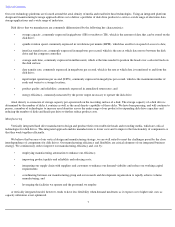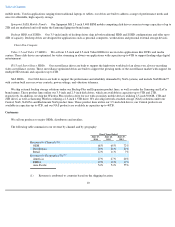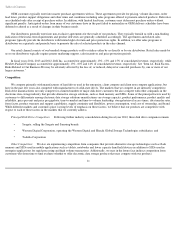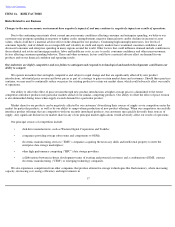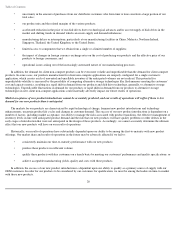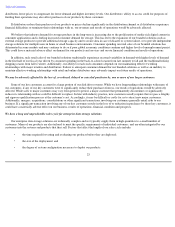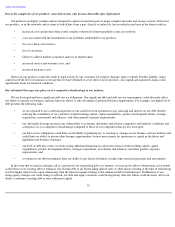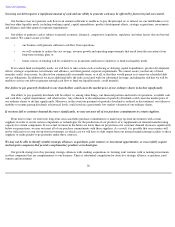Seagate 2013 Annual Report Download - page 20
Download and view the complete annual report
Please find page 20 of the 2013 Seagate annual report below. You can navigate through the pages in the report by either clicking on the pages listed below, or by using the keyword search tool below to find specific information within the annual report.
Table of Contents
ITEM 1A. RISK FACTORS
Risks Related to our Business
Changes in the macroeconomic environment have negatively impacted, and may continue to, negatively impact our results of operations.
Due to the continuing uncertainty about current macroeconomic conditions affecting consumer and enterprise spending, we believe our
customers may postpone spending in response to tighter credit, unemployment, negative financial news and/or declines in income or asset
values, which could have a material adverse effect on the demand for our products. Continuing high unemployment rates, low levels of
consumer liquidity, risk of default on sovereign debt and volatility in credit and equity markets have weakened consumer confidence and
decreased consumer and enterprise spending in many regions around the world. Other factors that could influence demand include conditions in
the residential real estate and mortgage markets, labor and healthcare costs, access to credit, consumer confidence and other macroeconomic
factors affecting consumer spending behavior. These and other economic factors could have a material adverse effect on demand for our
products and on our financial condition and operating results.
Our industries are highly competitive and our failure to anticipate and respond to technological and market developments could harm our
ability to compete.
We operate in markets that are highly competitive and subject to rapid change and that are significantly affected by new product
introductions, substantial price erosion and lower prices as part of a strategy to gain or retain market share and customers. Should these practices
continue, we may need to continually reduce our prices for existing products to retain our market share, which could adversely affect our results
of operations.
Our ability to offset the effect of price erosion through new product introductions at higher average prices is diminished to the extent
competitors introduce products into particular markets ahead of our similar, competing products. Our ability to offset the effect of price erosion
is also diminished during times when supply exceeds demand for a particular product.
Market share for our products can be negatively affected by our customers' diversifying their sources of supply as our competitors enter the
market for particular products, as well as by our ability to ramp volume production of new product offerings. When our competitors successfully
introduce product offerings that are competitive with our recently introduced products, our customers may quickly diversify their sources of
supply. Any significant decline in our market share in any of our principal market applications would adversely affect our results of operations.
Our principal sources of competition include:
• disk drive manufacturers, such as Western Digital Corporation and Toshiba;
• companies providing storage subsystems and components to OEMs;
• electronic manufacturing services ("EMS") companies acquiring the necessary skills and intellectual property to enter the
enterprise data storage marketplace;
• other high performance computing ("HPC") data storage providers;
• collaborations between in-house development teams of existing and potential customers and a combination of EMS, contract
electronic manufacturing ("CEM") or emerging technology companies.
We also experience competition from other companies that produce alternative storage technologies like flash memory, where increasing
capacity, decreasing cost, energy efficiency and improvements in
17


